|
Jump to What We Did and Why It Matters:
Working Green for a Sustainable Future
Our responsibility to our children and future generations extends beyond our commitment to providing environmentally responsible cleaning and packaging solutions. We do not just “clean green” – we work, think, and live green.
Below are green initiatives we proudly implemented within our office and warehouse that was completed in 2011. Our commitment and passion for protecting the environment and promoting green practices and technologies has rewarded our company with an extraordinary energy savings of over 50% – that’s 50% less energy costs, 50% less non-renewable resources consumed, and 50% less of a harmful impact on the environment. We pride ourselves on not only being a green partner and resource to our customers, but also a leader and model for businesses that strive to work green.
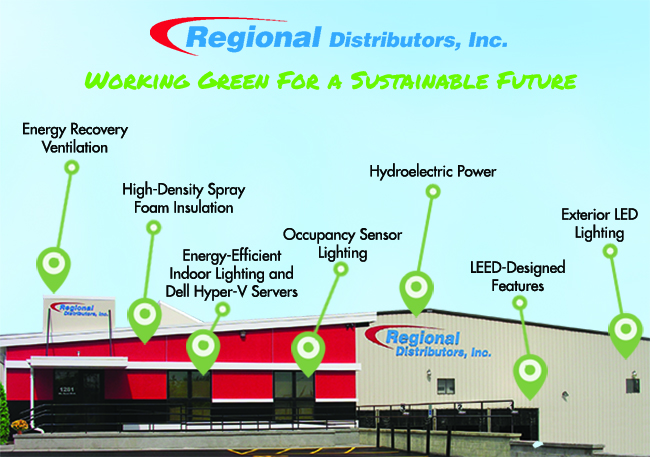
Green Initiatives & Building Features
| What We Did - Hydroelectric Power |
|
Why It Matters |
|
Utilization of hydroelectric power (renewable energy source) throughout building to power.
How hydropower works:
Hydropower is one of the largest sources of clean, renewable energy used in the U.S. It accounts for roughly 6 to 8 percent of all electricity produced within the country.
Hydropower typically works by damming up a water source to build up pressure. By channeling the water through the dam, the strength of the water flow is increased. The power of this flow turns turbines, which in turn are connected to generators that produce energy. This energy is turned into hydroelectric power, which is then delivered to the nation's electricity grid.
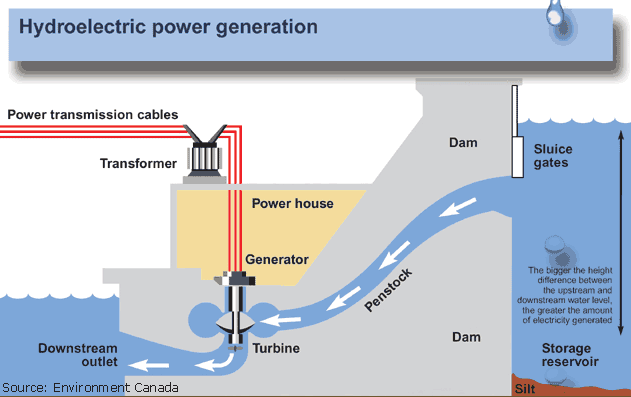
|
Electricity generation is the leading cause of industrial air pollution in the U.S. Most of our electricity comes from coal, nuclear, and other non-renewable power plants. Producing energy from these resources takes a severe toll on our environment, polluting our air, land, and water. Renewable energy sources (solar electric, wind, geothermal, biomass, and small and low-impact hydro) can be used to produce electricity with fewer environmental impacts. It is possible to make electricity from renewable energy sources without producing CO2, the leading cause of global climate change.
Benefits of hydropower include:
- Largest and leading source of clean electricity, accounting for almost 70% of all renewable energy generation in the U.S.
- Reliable source of power in the U.S. for over 100 years. That proven reliability benefits the national electric grid in a number of ways, from supporting other renewable energy sources to stabilizing the network to storing electricity for later use.
- Low cost source of renewable electricity and is among the most cost effective energy sources as it taps the self-renewing power of waterways and is not subject to unpredictable price shifts.
- Avoids the emission of over 225 million metric tons of carbon pollution in the U.S. each year.
- Hydropower facilities also provide vital benefits such as flood control, navigation, irrigation, water supply, and a range of recreational opportunities.
- Visit ga.water.usgs.gov/edu/wuhy.html to learn more.
|
| What We Did - Green Products |
|
Why It Matters |
|
Use of environmentally responsible products to clean, sanitize, and stock our workspace.
|
Using and promoting green products in the office creates an environmentally-healthy environment and perpetuates sustainable change as staff and customers will be more inclined to bring these products and practices home.
Look for these logos when shopping or procuring products.
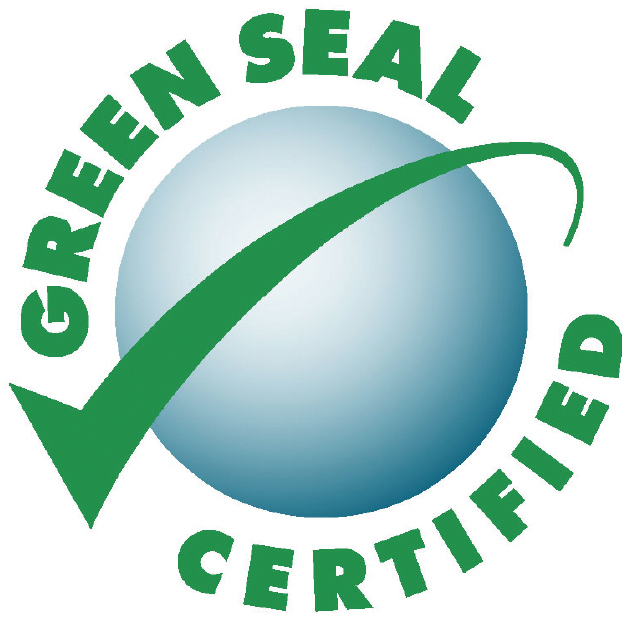 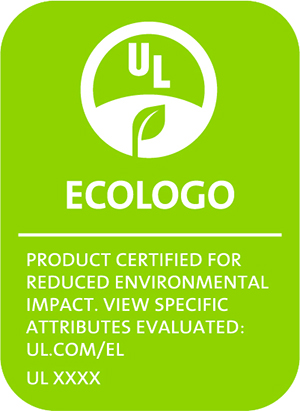 
|
| What We Did - Recycling |
|
Why It Matters |
We recycle used pallet wrap and all plastics, papers, and recyclable materials in proper receptacles and ensure collection.
Some suggested Green Seal, EcoLogo, and other recycled, alternative, and recyclable products available through Regional Distributors are:
|
The Reduce, Reuse, Recycle mantra provides easy and significantly effective methods to develop a healthier cleaning and sustainable practice for your business, building, workforce, and home.
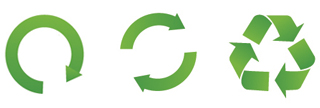
Reduce through controlled consumption of water, energy, and goods used.
Reuse paper, smallwares, containers, and other reusable products multiple times.
Recycle materials responsibility and investigate products made from recycled and alternative materials. |
| What We Did - E-Statements |
|
Why It Matters |
Beginning May 2014, instead of receiving a paper statement in the mail, Regional will email customers an electronic copy of their statement.
Simple. Easy. Green.
 |
E-statements are an easy and simple way to preserve the environment by reducing paper waste, energy consumption, and our carbon footprint.
- Faster than regular mail and usually available the first to third business day of the month.
- More secure - no worry of your statement being lost or stolen.
- Helps save trees used for paper statements.
- Quickly and conveniently save statements to your computer cutting down on clutter and space consumption in your home.
- Conserves energy used to make and print paper statements.
- Reduces greenhouse gas emissions from the delivery of paper statements.
|
| What We Did - LEED Designed |
|
Why It Matters |
|
Regional’s headquarters are classified as a LEED designed building for implementing a number of requirements designated by the U.S. Green Building Council (USGBC).
Some LEED features within our office include:
- Light pollution reduction
- Water use reduction
- Water efficient landscaping
- Optimized energy performance
- Storage and collection of recyclables
- Enhanced refrigeration management
- Green power (hydro electric)
- Building reuse
- Increased ventilation
- Low-emitting materials
- Indoor chemical and pollutant source control
- Controllability of systems (lighting and thermal comfort)
- Thermal comfort
- Daylight and views
|
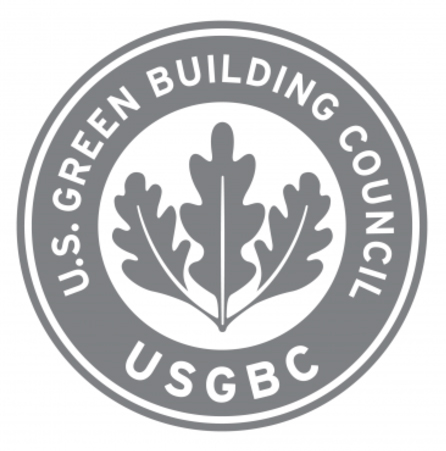 Developed by the U.S. Green Building Council (USGBC), Leadership in Energy and Environmental Design (LEED) is transforming the way we think about how our buildings, homes and communities are designed, constructed, maintained, and operated across the globe. The LEED rating systems is a green building tool that addresses the entire building lifecycle and provides building owners and operators with a framework for identifying and implementing practical and measurable green building design, construction, operations and maintenance solutions. Developed by the U.S. Green Building Council (USGBC), Leadership in Energy and Environmental Design (LEED) is transforming the way we think about how our buildings, homes and communities are designed, constructed, maintained, and operated across the globe. The LEED rating systems is a green building tool that addresses the entire building lifecycle and provides building owners and operators with a framework for identifying and implementing practical and measurable green building design, construction, operations and maintenance solutions.
Benefits of LEED:
- Lower operating costs and increase asset value
- Conserve energy, water, and other resources
- Be healthier and safer for occupants
- Qualify for money-saving incentives, like tax rebates and zoning allowances
|
| What We Did - Improved Air Quality |
|
Why It Matters |
Installation of RenewAire Energy Recovery Ventilation (ERV) System.
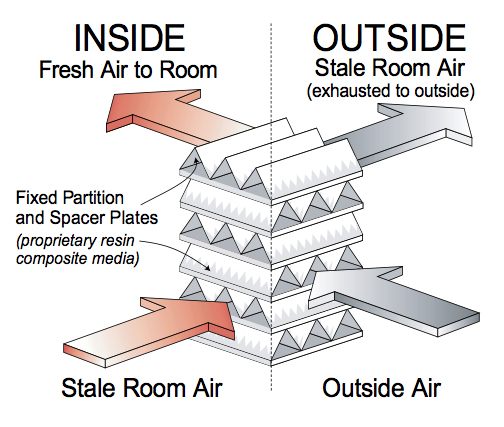 |
With homes and commercial buildings becoming more airtight, the need for better ventilation has become increasingly important. RenewAire Energy Recovery Ventilation (ERV) Systems provide better air quality by separating exhaust and fresh airstreams, moderates humidity and temperature extremes both in summer and winter, and removes excess carbon dioxide, formaldehyde, and other gaseous pollutants.
Benefits include:
- Improved air quality. Hydroscopic resin plates separate fresh air streams from exhaust air streams keeping air cleaner. Perfect for controlled exhaust applications such as restrooms and food service and healthcare facilities.
- Direct water vapor transfer that eliminates condensation and frosting in virtually all applications and climates. No condensation results in higher efficiencies, easier installations, and eliminates the need for dampers and electrical defrost elements that reduce ventilation and counteracts energy efficiencies.
|
| What We Did - Virtualization & Server Consolidation |
|
Why It Matters |
|
Implemented virtualization strategy and consolidated five (5) servers into one (1) Dell Hyper-V server.
INFOGRAPHIC: Microsoft Virtualization and Private Cloud Trends.
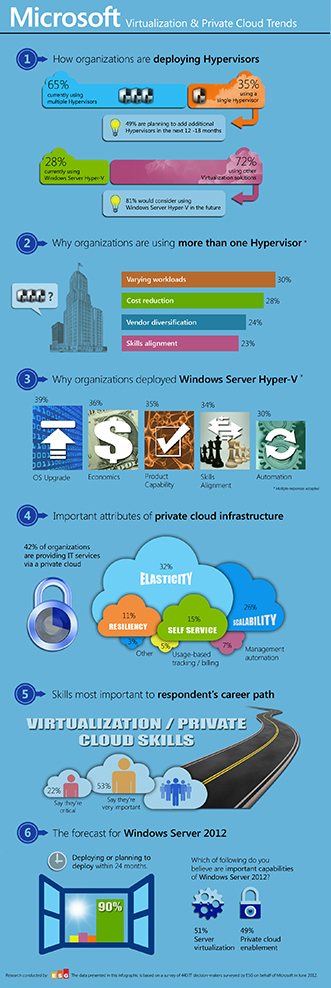
Credit: Microsoft.
|
More and more small and medium businesses are turning to virtualization as a way to reduce the total number of physical servers needed to support and expand their business. Virtualization allows physical servers to be divided into multiple, independent server environments. Rather than running one application per server (one server for the accounting application, one for customer service, etc.) one physical server running virtualization software can run many applications reducing space and energy consumption.
Benefits of virtualization:
- Reduces data center power and cooling requirements that in turn greatly reduces energy consumption and utility costs by approx. 30–50%.
Cost Savings Example: Power and cooling costs are estimated to be $200 per server, per month. That’s $2,400 per server, per year. Multiply that by the decent number of servers most small and medium businesses maintain and it’s easy to see how reducing the number of servers could add up to significant savings.
Using Regional Distributors as an example, it cost approx. $12,000 per year to power and cool five servers. After consolidating into one Dell Hyper-V server, the annual cost is now approx. $2,400 – that’s an annual savings of $9,600 that can be reallocated to other technologies, sales support, and business operations.
- Consolidating servers reduces the amount of square footage required by the data center saving money on space.
- Lowers the cost of IT overhead by decreasing the number of servers to manage (update, repair, etc.) freeing up IT staff time for other strategic projects.
- Offers greater flexibility through automated power management, live migration, and workload balancing.
- Allows IT staff to easily shift loads from server to server to keep every machine fully utilized eliminating unused processor and memory resources.
|
| What We Did - Energy-Efficient Indoor Lighting |
|
Why It Matters |
Installation of Metalux Paralux III Modular parabolic lighting systems with Sylvania Universal Voltage T8 lamp tuned ballast technology throughout interior of building.
Indoor Lighting Design Tips
Energy-efficient indoor and outdoor lighting design focuses on ways to improve both the quality and efficiency of lighting. If you're constructing a new house or business, consider lighting as part of your whole-house/building design – an effective approach for building an energy-efficient space. When designing indoor lighting for energy efficiency, consider some basic design principles and tips:
- More light is not necessarily better. Light quality is as important as quantity.
- Match the amount and quality of light to the performed function.
- Install task lights where needed and reduce ambient light elsewhere.
- Use energy-efficient lighting components, controls, and systems.
- Maximize the use of daylighting.
|
Parabolic lighting systems are designed to balance sufficient light output and energy conservation. By reflecting light more, parabolic lighting:
- conserves energy and reduces bulb usage.
- reduces glare and excessive brightness.
- enhanced optics delivers significantly increased energy efficiency.
T8 lamp tuned ballast technology:
- reduces power usage and provides and energy savings of 30 – 40%.
- are longer lasting.
- eliminates lamp flicker.
Overall benefit to Regional:
- Annual Energy Removed: 130,980 kWh equaling a 72% lighting energy reduction
- Annual Energy Savings: Approx. $13,000
Overall annual environmental benefits:
- Prevent the emission of 47 tons of carbon dioxide.
- Prevent the emission of 394 lbs. of sulfur dioxide.
- Prevent the emission of 109 lbs. of nitrogen oxides.
- Equivalent to planting 235 trees annually.
|
| What We Did - LED Exterior Lighting |
|
Why It Matters |
|
Utilization of LED lightbulbs in all exterior building lights.
The Lighting Facts Label
Starting in 2012, a new Lighting Facts label will appear on light bulb packages. The Federal Trade Commission is requiring the label on all light bulb packages to help consumers easily compare energy-efficient light bulbs. The label includes:
- Brightness, measured in lumens
- Estimated yearly energy cost (similar to the Energy Guide label)
- Lifespan
- Light appearance (from warm to cool)
Energy used, measured in watts. Like the helpful nutrition label on food products, the Lighting Facts label will help you to understand exactly what you are buying and to buy the light bulbs that are right for you.

|
LED (light-emitting diodes) lighting is the most energy-efficient and rapidly-developing lighting technology. LED lightbulbs are more durable, offer comparable or better light quality than other types of lighting, and use at least 75% less energy, and last 25 times longer, than incandescent lighting.
In 2012, about 49 million LEDs were installed in the U.S. – saving about $675 million in annual energy costs. Switching entirely to LED lights over the next two decades could save the U.S. $250 billion in energy costs, reduce electricity consumption for lighting by nearly 50 percent, and avoid 1,800 million metric tons of carbon emissions.
Outdoor Lighting Tips
- LEDs work well indoors and outdoors because of their durability and performance in cold environments. Look for LED products such as pathway lights, step lights, and porch lights for outdoor use. You can also find solar powered outdoor lighting.
- Because outdoor lights are usually left on a long time, using CFLs (compact fluorescent lights) or LEDs in these fixtures will save a lot of energy. Most bare spiral CFLs can be used in enclosed fixtures that protect them from the weather.
- CFLs and LEDs are available as flood lights. These models have been tested to withstand the rain and snow so they can be used in exposed fixtures.
- Look for ENERGY STAR® qualified fixtures that are designed for outdoor use and come with features like automatic daylight shut-off and motion sensors.
|
| What We Did - Occupancy Sensor Lighting |
|
Why It Matters |
Installation of occupancy sensor lights throughout building interior.
Occupancy sensors detect indoor activity within a certain area. They provide convenience by turning lights on automatically when someone enters a room, and save energy by turning lights off soon after the last occupant has left the room. Occupancy sensors must be located where they will detect occupants or occupant activity in all parts of the room.
There are two types of occupancy sensors: ultrasonic and infrared. Ultrasonic sensors detect sound, while infrared sensors detect heat and motion. In addition to controlling ambient lighting in a room, they are useful for task lighting applications such as over kitchen counters. Task lights are turned on by the motion of a person washing dishes, for instance, and automatically turn off a few minutes after the person leaves the area. |
According to the U.S. Environmental Protection Agency (EPA), energy savings from using occupancy sensor lights can range from 40% to 46% in classrooms, 13% to 50% in offices, 30% to 90% in restrooms, 22% to 65% in conference rooms, 30% to 80% in corridors, and 45% to 80% in storage areas.
Benefits include:
- Lowers energy costs by reducing energy waste and consumption.
- Minimizes light pollution by reducing the usage of lighting operating at night.
- Inexpensive, effective devices that can quickly and easily be installed on a wall or ceiling.
- Utility rebates may be available – check with your local utility. Where utility rebates are available, sensors pay for themselves in less than one year, but most pay for themselves in two to three years without rebates.
|
|